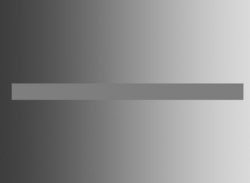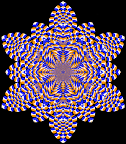An optical illusion is any illusion that deceives the human visual system into perceiving
something that is not present or incorrectly perceiving what is present. There are physiological illusions and cognitive illusions.
Optical illusions can naturally happen by specific optical tricks that show particular assumptions in the human perceptual system.
A mirage is a natural illusion that is an optical phenomenon.
The variation in the apparent size of the Moon (smaller when overhead, larger when near the horizon) is another natural illusion; it is not an optical phenomenon, but rather a cognitive or perceptual illusion.
Developed illusions include phenomena such as the Necker cube and the Scintillating/Hermann grid. They could also be called discovered illusions. Understanding these phenomena is useful in order to understand the limitations of the human visual system.
Physiological illusions, such as the afterimages following bright lights or adapting stimuli of excessively longer alternating patterns (contingent perceptual aftereffect, CAE), are the effects on the eyes or brain of excessive stimulation of a specific type - brightness, tilt, colour, movement, and so on. The theory is that stimuli have individual dedicated neural paths in the visual outer wall of an organism for the early stages of visual processing; repetitive stimulation of only a few channels misleads the visual system.
Cognitive illusions are more interesting and well-known. Instead of demonstrating a physiological base they interact with different levels of perceptual processing, in-built assumptions or 'knowledge' are misdirected. Cognitive illusions are commonly divided into ambiguous illusions, distorting illusions, paradox illusions, or fiction illusions. They often exploit the predictive hypotheses of early visual processing. Stereograms are based on a cognitive visual illusion.
Ambiguous illusions are pictures or objects that offer significant changes in appearance. Perception will 'switch' between the alternates as they are considered in turn as available data does not confirm a single view. The Necker cube is a well known example, the motion parallax due to movement is being misinterpreted, even in the face of other sensory data.
Distorting illusions are the most common, these illusions offer distortions of size, length, or curvature. They were simple to discover and are easily repeatable. Many are physiological illusions, such as the Cafe wall illusion which exploits the early visual system encoding for edges. Other distortions, such as converging line illusions, are more difficult to place as physiological or cognitive as the depth-cue challenges they offer are not easily placed. All pictures that have perspective cues are in effect illusions. Visual judgements as to size are controlled by perspective or other depth-cues and can easily be wrongly set.
Paradox illusions offer objects that are paradoxical or impossible, such as the Penrose triangle or impossible staircases seen, for example, in the work of M. C. Escher. The triangle is an illusion dependent on a cognitive misunderstanding that adjacent edges must join. They occur as a byproduct of perceptual learning.
Fiction illusions are the perception of objects that are genuinely not there to all but a single observer, such as those induced by schizophrenia or hallucinogenic drugs.
Known illusions include:
- Ames room illusion
- Ames trapezoidal window illusion
- Benham's top
- Cafe wall illusion
- Converging line distortion illusion
- Craik-O'Brien-Cornsweet illusion
- Fraser spiral illusion
- Hering figure
- Hermann grid illusion
- Impossible trident illusion
- Mach band
- Missing square puzzle
- Moon illusion
- Ponzo illusion
- Muller-Lyer distortion illusion
- Necker cube illusion
- Phi phenomenon
- Penrose triangle aka Impossible triangle illusion
- Poggendorf Illusion
- Scintillating illusion
- Pulfrich effect or Pulfrich pendulum illusion
- Size-weight illusion
- Illusory figure, Kanizsa's pattern
- Stroop effect
Many artists have worked with optical illusions, some extensively, including M.C. Escher, Salvador Dalí, Giuseppe Arcimboldo, Marcel Duchamp, Oscar Reutersvärd and anyone who has ever worked with perspective.












0 comments:
Post a Comment | Random Illusion